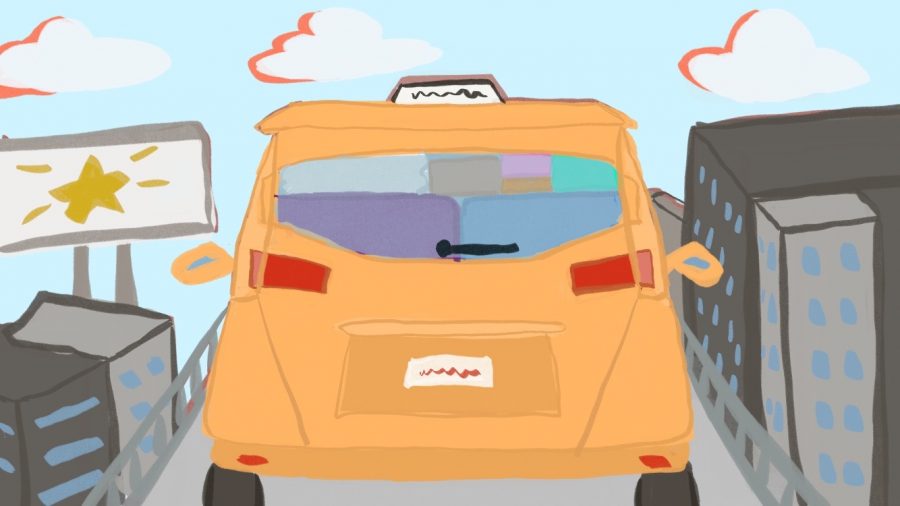When I moved to India at the age of nine, it became easy and almost natural to associate everything good I had ever known with America: annual passes to Disneyland, self-checkout counters at Walmart and piling enormously unhealthy amounts of shredded cheese onto a steaming plate of calamari at Olive Garden. I could barely remember my early childhood, but these distinct flashes of memories made me romanticize the life I had back in the states. India was a foreign place that lacked the ice cream trucks I had grown to love and the picturesque maple trees and wide roads to which I was so accustomed.
I would visit India during my summer vacations for a month at most. These visits were a blur, because of my distorted memory and the utter chaos of dozens of relatives coddling me, stuffing me with spicy snacks and admiring my distinct American accent. It never crossed my mind that these were just preludes to what would become the biggest and most jarring shift in my life.
This doesn’t mean that India, or in particular Hyderabad, didn’t grow on me. My memories are deeply rooted in my Indian culture, with most conversations revolving around my “Indianness.” My spice tolerance has dramatically increased; I can now brazenly jaywalk on the busiest and most chaotic Old City streets whilst maneuvering around auto rickshaws and motorists more than willing to run me over; and even my accent turned noticeably Indian, despite my numerous failed attempts to recreate the American accent I once had.
Growing up in both countries, I noticed major cultural differences between India and America: Indians favor social harmony over furthering one’s own goals, and privacy is not just a given right like it is in America. However, it’s not all that bad in India: we have a sense of community and structure that Americans don’t, to the point where I felt sheltered from the adversities of the real world. While you’d never truly be independent, it’s still nice to always have people you can depend on.
After finally revisiting America after my nine-year stint in India, I was able to form a more developed comparison of my two homes. People are a lot more confrontational in America, to the point where you’re afraid to slip up and accidentally anger someone. That’s a unique trait of individualistic cultures, where people aren’t afraid to speak their mind, even when it results in social tension. At the same time, exchanging over-the-top pleasantries is commonplace in the United States. This was something that proved to be a monumental task for me at first. It’s hard to force yourself to make small talk and say “thank you” every five seconds when you come from a place where interactions between people who don’t know each other are quite limited. It’s an interesting and bizarre clash of attitudes, and I’m still trying to find the line separating them.

When my family landed in New York City, brimming with excitement after the arduous 18-hour flight, we did not receive the warm welcome we expected. Like a true tourist family, we had decided to take one of those large unmetered cabs from JFK to Manhattan. It did make sense at the time, considering how much luggage we had, but we should’ve realized the shadiness of the situation when the driver insisted that an app on his phone would determine the trip’s fare.
Nevertheless, we made pathetic attempts at pretending we were real New Yorkers, with my dad shushing me every time I tried asking the driver where we were, in an effort to ensure he wouldn’t inflate the fare. It didn’t work. We definitely didn’t know our way around the city and the driver did, which is why it didn’t occur to us to question the multiple, almost dizzying, turns he seemed to be taking every minute.
We eventually reached our Marriott Hotel and began the arduous process of unloading the luggage when I overheard my dad trying, and failing, to discreetly argue with the cabbie. Unsurprisingly, the fare was outrageous. However, what surprised me the most was the incredibly drastic change in his behavior.
The man we had spent over an hour making delightful small talk with became almost unrecognizable. He was red with anger and, ironically, yelling at my dad about how he felt cheated. A couple minutes of heated arguing turned into him openly cursing at all of us, for everyone to hear. A harsh “F-ck you” cut through the air but no one around us even bat an eye in response to what was happening.
This was New York in all of its normalcy.
In India, arguments always happened behind closed doors and in hushed whispers. Often, a side-eye is more than enough to put someone in their place; to actually utter “F-ck you” would be atrocious. My romanticized reconstruction of life in America was crashing before my very eyes, leaving me in a state of perplexity over the sudden realization that this was going to be my home for the next four years. I experienced major culture shock the moment I stepped out of the airport. This tainted my otherwise touristy and colorful Times Square view of New York City.
Coming from a major metropolitan city in India, I assumed it wouldn’t be that hard to adjust to high-paced city life. But maybe there’s just something about New York City that makes its residents unnervingly confrontational. It’s not uncommon to be harassed by petitioners at every corner, or to watch a fight break out on the street in broad daylight, or have a dealer sneak up on you from behind whilst you’re walking down West Fourth and whisper, “You kids want weed?”
What would be considered unthinkable in India, such as a waitress passive aggressively badgering you for a tip, is just part of the experience when you go out to eat at Union Square. Even the squirrels and pigeons in Washington Square Park approach people with an unsettling lack of fear, almost as if they’re challenging you.
Perhaps my difficulties adjusting arise from the fact that this isn’t really my home, or the home I envisioned. I feel like I’ve been dropped into the most vibrant and dynamic city in the world with all this freedom I could only have dreamt of back in India. I’m not used to being allowed to walk alone in the streets (even during the day), and I certainly can’t get over the fact that I can now talk to the opposite sex without fear of the inevitable ensuing gossip.
It’s liberating yet strangely discomforting; I’m now completely in control of my actions and the repercussions that follow them. I can’t deny I’ve lived a sheltered life for the past nine years, one where I often felt immensely suffocated, and now I can’t deny how the freedom can be overwhelming at times. It’s difficult to strike a balance in the Land of Liberty and I often find myself engaging in rather contradictory behaviors. I’d stay up till 3 a.m. for no good reason while being incredibly pedantic about my daily schedule just because I can.
I don’t think it’s possible for me to dislike New York, despite the fact it will never feel like home. There are benefits, like revisiting Olive Garden and relishing my long lost childhood — despite the fact that as an adult, I now need to personally request the waiter to pile on the cheese. But there’s a limit to how much I can marvel at the famed maple trees and the stereotypical wide roads that accompany them before I start to feel homesick for the chaos associated with India. Jaywalking just doesn’t feel the same when there are legitimate zebra crossings, and neither does risking typhoid at a sketchy street food cart when you know the cook is forced to wear gloves. India has always carried a sense of excitement and recklessness that New York cannot possibly offer.
I come from two very distinct homes, and they both look a little different every time I move, with the romanticization of one beginning as soon as I leave it. My years in India consisted of me yearning for my life in America and, as a cruel twist of fate, revisiting America has only left me longing for the life I actually remember.
Email Vaishnavi Naidu at [email protected].


























































































































































